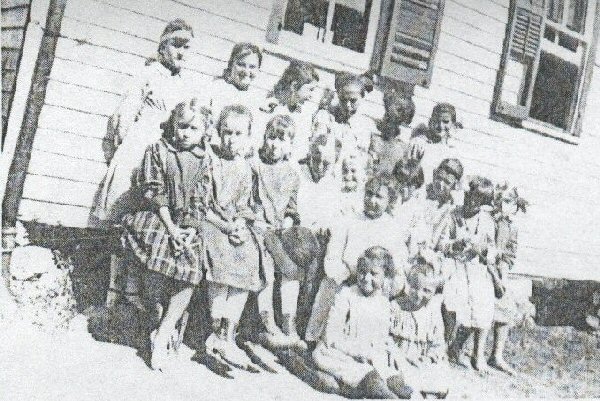|
Chandler School (Evansville
School) Land was donated for the school on
February 22, 1888 by William T. and Mary H. Chandler. Directors: E. C.
Broadus, Robert Cottingham, and John Engle. It was consolidated with Middle Grove in
1941 for high school education. 1950-51 was the last year classes were
held at Chandler. Chandler School 1919-1920
Boys: Charley Johnson, Harry Utterback, Bill
Burk, Fred Lepper, Luther Broaddus, Estin Meals, Lee Lepper, Delbert
Utterback, Arthur Null, I. Nichols, Kenneth Utterback, Arnold Brown,
Russell Riley, Artie Haise, Loyd Powell, Austin Powell, Gilbert Riley,
Bill Hopper
Girls: Back: Jewell Powell, Dorothy Meals,
Thelma Null, Dorothy Brown, Mattie Nichols, Mattie Utterback. Front Frost, Carry Mae Hopper, Lillian
Hopper, Wilma Murphy, Marie Feland, Elsie Cross, Francis Johnson, Mae
Powell, Utterback, Utterback, Virginia Powell, Dorothy Lepper
Mother awakened me by saying, “Alma
Jean, wear your overshoes when you go out to feed Euky and
Ticklebritches, it rained last night.” It seemed like I just went to
bed! I washed, and put on the clean clothes Mother had placed on a chair
the night before. Soon I was out feeding my bantam chicken and cat, and
back into the house to eat breakfast. Before we were finished, Mother
saw the Kirgan boys on our North side. That was a signal for us to get
into our caps, coats, and overshoes. When Roy, Ralph and Harry came
through our yard, we three Nulls; Thelma, Arthur & Alma were ready.
As we went through Evansville, Wilma Murphy and her step-brother, Artie
Hayes, joined us. Their father owned the saw mill. Clay Farrell owned
the store and his son, Roy joined us, as did Elsie Cross. She lived with
her grandparents, Willie McNear, who did odd jobs. The three Riley kids,
Nadine, Russell, Gilbert, always waited for us in the Wabash Station.
Their father, Al, was section boss and they lived by the tracks in the
section house. We were quite a gang five girls and nine boys. As we
approached the creek bridge, the Evansville bully ran ahead and said as
we climbed upon the bridge railing, “Follow the leader and get your
nose rubbed in it.” Everyone drove horses so there was plenty for
one’s nose to be rubbed in. I was the smallest of the gang and I held
back. Roy saw me come back, helped me upon the railing and held my hand. At the bridge we took a path through my
father’s farm. This saved us from walking on a muddy road. On Mondays
lots of cattle and hogs were driven to Evansville to be shipped. We were
urged to take the path, it was safer for us and we didn’t scatter the
livestock. We crossed the road and went across my grandfather, W. K.
Hall’s farm. Then through the B. Goslin woods. One time I asked whose
land it was and was told B. Goslin. I had heard about the birds and
bees, and not it was bees and goslins. As we enetered the school house, Miss
Mary Farrell finished washing the two water buckets and handed one to
Roy and the other to Russell. We were soon settled down to a day of
learning. While the older kids were at the black board, Miss Mary had
the first and second grade kids come to her desk and she would listen to
us read. Noon was a special time. Some would trade
part of their lunch, but I never would. I always wanted Wilma and Elsie to go to
the toilet with me. We would open the door and jump back and see what
would run out. It was full of spider webs, devils darn needles and oak
leaves. Near by was a little branch, and that is where we played. In
1919 or 20 there was no playground equipment. We played with acorns. We
took the cap off and filled it with moist sand. We thought we had pretty
pies. We hunted for pretty rocks. The older kids played Blackman, fox
and geese, and ball. About 3 o’clock Wilma, Elsie and I were asked to take the erasers outside and dust them. Two of the older boys would fill the buckets with coal and empty the buckets of water. Soon the bell would ring and I was one day closer to reading Black Beauty for myself. |



 Memories of Alma Jean Null
Memories of Alma Jean Null